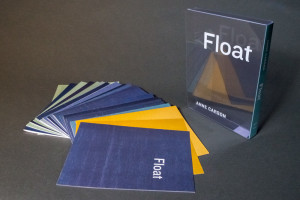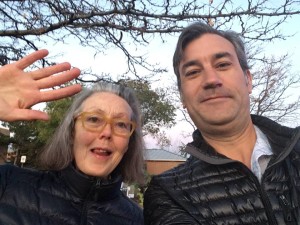Tags
Related Posts
Share This
Between Something and Nothing

In Anne Carson’s “Float,” each chapbook contains a separate piece of writing that expertly fits into the piece as a whole. Photo by Jennifer Rapinchuk
In describing Anne Carson’s work, one runs into a difficulty, for her work’s largest unifying feature is that everything is subject to change. On Oct. 26, the Lannan Foundation hosted a reading at The Lensic Performing Arts Center—Anne Carson in conversation with Michael Silverblatt, an experience not soon to be forgotten and, as with Carson’s work, difficult to categorize.
By Carson’s hand, everything is mutable. Everything is malleable, from genre to myth to form. Carson has published a multitude of collections and books, some notable ones including Autobiography of Red: A Novel in Verse; Nox, an accordion-style book that revolves around grief; Eros the Bittersweet; Glass, Irony, and God; and now Float, which is less a book and more a series of individual chapbooks that literally seem to float inside a plastic case. These chapbooks can be read in any order; the works are listed alphabetically in the table of contents, which differs from the order in which they first appear in Float. In the words of Michael Silverblatt, Anne Carson “knows something about aesthetics, something no one else knows.” Silverblatt introduced Carson by praising her use of language; in Carson’s hands, language is “stinking fresh,” fresh and still living. Her writing is a relief. Only five minutes into the night, and it was already clear the audience was in for something special.
Carson read the entirety of her “Essay on Threat,” an essay in three parts exploring the permutations of threat as filtered through the experiences of an expert forensic witness embroiled in a local drug war. If that sounds dark, it is—and funny. One cannot avoid laughing when the narrator is joined by carrion crows to assist in some “continual minor delinquency” against the major players in the town drug scene. Carson has balanced the essay on the fine knife’s edge of the absurd and the tragic, the final result of which is a darkly comic masterpiece. From a rich judge’s kidnapped egret (“ransom was paid; they slaughtered the egret, anyway”) to the narrator subsisting on gummy bears and Ryvita while dissecting the five drug-scene-significant lives to a talking crow named Shortpants (“Where did he learn pronoun function?”), humor is often found. In a soft voice, Carson dryly offered this description of the narrator’s life— “Mother and father gone, no children, wife, or waterfowl. Someone would have to grasp at straws to find a way of menacing me.” Between the comical lies the tragic—a schoolmaster stops paying the protection payment and the schoolchildren are gunned down in retribution, fueling the narrator’s drive to “lower the quality of those five lives just a bit every minute of their lives.”
In listening to the narrator’s description of their “threats,” which read more like malicious pranks, the audience broke into laughter. A pizza is delivered to a man’s house, his wife’s password written in black olives, his mistress’s password in red pepper. Shortpants rouses another man’s dog by mimicking the exact tone of his master’s voice, a prank that continues nine nights in a row. Another time, they commence plucking a pet peacock’s tail feathers, a little bit at a time, so that the peacock just topples over one day, unbalanced. Shortpants whitewashes another man’s porch.
The essay defied expectations, with parts one and two being long and part three being extremely short, ending almost before the audience realized it was finished. Later, Silverblatt addressed the lack of resolution in part three, the way that Carson “denies answers” to her audience. In conversation, Silverblatt had a knack for blasting open Carson’s work with snappy observations, like “our need for answers…is perhaps the need we are most punished for in our lives.” Addressing the lack of resolution, Carson pondered aloud that she didn’t want the audience to take this experience home with them; she’d rather they be in an experience and then let it go away. Ephemerality. “What does an answer answer?” She asked. What does an answer offer? She encouraged listeners to let go of the presumption of answer, to simply travel with a story as it unfolds.
The night ended with a book signing and a line of eager audience members that almost stretched out the door of the Lensic lobby. In a slowly-dwindling crowd, attendees tore open the plastic wrap that sealed Float and thumbed through the chapbooks as though the entire book was a cipher to be solved.
Again with the addiction to answers.

Anne Carson serendipity: In which, driving home from her reading, you realize that all the people flashing their lights at you on the road are actually trying to tell you that both of your own headlights are out, and after you park the car and Uber your way home, you return the next morning only to find your access to your car blocked by several police cars, and just as you are being told by the policeman that you won’t be getting anywhere near your car in order to drive your kids to school due to a bomb threat on the block where you happened to park, you notice AC casually walking through the police perimeter, and you find yourself yelling in real life, not in some lame anxiety dream about your own work “Hey, Anne Carson, don’t go down that road, there’s a bomb!” And then you say “hi” and for no good reason at all ask for a just-barely-dawn selfie with her. Photo and text by Matt Donovan.






 Jackalope Magazine is the student magazine of Santa Fe University of Art and Design. Building on the interdisciplinary nature of our education, we aim to showcase the talent of our university and character of our city.
Jackalope Magazine is the student magazine of Santa Fe University of Art and Design. Building on the interdisciplinary nature of our education, we aim to showcase the talent of our university and character of our city.
0 Comments
Trackbacks/Pingbacks